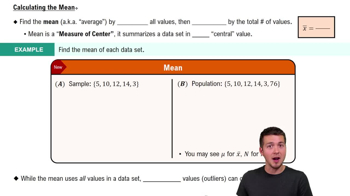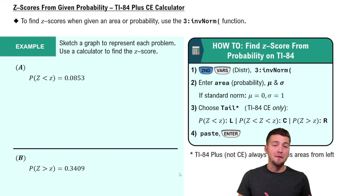Minting Quarters Listed below are weights (grams) of quarters minted after 1964 (based on Data Set 40 “Coin Weights” in Appendix B). Construct a 95% confidence interval estimate of the mean weight of all quarters minted after 1964. Specifications require that the quarters have a weight of 5.670 g. What does the confidence interval suggest about that specification?
Table of contents
- 1. Intro to Stats and Collecting Data1h 14m
- 2. Describing Data with Tables and Graphs1h 55m
- 3. Describing Data Numerically2h 5m
- 4. Probability2h 16m
- 5. Binomial Distribution & Discrete Random Variables3h 6m
- 6. Normal Distribution and Continuous Random Variables2h 11m
- 7. Sampling Distributions & Confidence Intervals: Mean3h 23m
- Sampling Distribution of the Sample Mean and Central Limit Theorem19m
- Distribution of Sample Mean - Excel23m
- Introduction to Confidence Intervals15m
- Confidence Intervals for Population Mean1h 18m
- Determining the Minimum Sample Size Required12m
- Finding Probabilities and T Critical Values - Excel28m
- Confidence Intervals for Population Means - Excel25m
- 8. Sampling Distributions & Confidence Intervals: Proportion1h 12m
- 9. Hypothesis Testing for One Sample3h 29m
- 10. Hypothesis Testing for Two Samples4h 50m
- Two Proportions1h 13m
- Two Proportions Hypothesis Test - Excel28m
- Two Means - Unknown, Unequal Variance1h 3m
- Two Means - Unknown Variances Hypothesis Test - Excel12m
- Two Means - Unknown, Equal Variance15m
- Two Means - Unknown, Equal Variances Hypothesis Test - Excel9m
- Two Means - Known Variance12m
- Two Means - Sigma Known Hypothesis Test - Excel21m
- Two Means - Matched Pairs (Dependent Samples)42m
- Matched Pairs Hypothesis Test - Excel12m
- 11. Correlation1h 6m
- 12. Regression1h 50m
- 13. Chi-Square Tests & Goodness of Fit1h 57m
- 14. ANOVA1h 57m
7. Sampling Distributions & Confidence Intervals: Mean
Confidence Intervals for Population Mean
Problem 12.CR.6b
Textbook Question
Quarters Assume that weights of quarters minted after 1964 are normally distributed with a mean of 5.670 g and a standard deviation of 0.062 g (based on U.S. Mint specifications).
b. If 25 quarters are randomly selected, find the probability that their mean weight is greater than 5.675 g.
 Verified step by step guidance
Verified step by step guidance1
Step 1: Identify the given values in the problem. The population mean (μ) is 5.670 g, the population standard deviation (σ) is 0.062 g, and the sample size (n) is 25. The problem asks for the probability that the sample mean weight is greater than 5.675 g.
Step 2: Calculate the standard error of the mean (SEM). The SEM is given by the formula: , where σ is the population standard deviation and n is the sample size.
Step 3: Standardize the sample mean using the z-score formula: . Here, X is the sample mean (5.675 g), μ is the population mean (5.670 g), and SEM is the standard error of the mean calculated in Step 2.
Step 4: Use the z-score obtained in Step 3 to find the corresponding probability. This can be done by looking up the z-score in a standard normal distribution table or using statistical software to find the cumulative probability.
Step 5: Subtract the cumulative probability from 1 to find the probability that the sample mean weight is greater than 5.675 g. This is because the problem asks for the probability in the upper tail of the distribution.
 Verified video answer for a similar problem:
Verified video answer for a similar problem:This video solution was recommended by our tutors as helpful for the problem above
Video duration:
2mPlay a video:
Was this helpful?
Key Concepts
Here are the essential concepts you must grasp in order to answer the question correctly.
Normal Distribution
Normal distribution is a probability distribution that is symmetric about the mean, showing that data near the mean are more frequent in occurrence than data far from the mean. In this context, the weights of quarters follow a normal distribution, which allows us to use statistical methods to calculate probabilities related to their mean.
Recommended video:
Guided course

Finding Standard Normal Probabilities using z-Table
Central Limit Theorem
The Central Limit Theorem states that the sampling distribution of the sample mean will be normally distributed, regardless of the shape of the population distribution, provided the sample size is sufficiently large (typically n > 30). In this case, with a sample size of 25, we can still apply the theorem to approximate the distribution of the sample mean of quarter weights.
Recommended video:
Guided course

Calculating the Mean
Z-Score
A Z-score measures how many standard deviations an element is from the mean. It is calculated by subtracting the mean from the value and dividing by the standard deviation. In this problem, we will use the Z-score to determine the probability that the mean weight of the selected quarters exceeds 5.675 g by standardizing the sample mean.
Recommended video:
Guided course

Z-Scores From Given Probability - TI-84 (CE) Calculator

 4:48m
4:48mWatch next
Master Population Standard Deviation Known with a bite sized video explanation from Patrick
Start learningRelated Videos
Related Practice
Textbook Question
